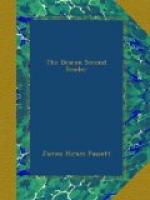John knew that the Indians might kill him if he warned his brother.
But he was brave, and before they could stop him, he cried out, “Indians! Indians!”
The Indians were angry and struck at John with their tomahawks.
But he was not afraid; he faced the Indians bravely.
William heard the shout of warning, and ran like a deer back to the log cabin.
The heavy door was shut with a slam, and John’s father, with his rifle, waited for the Indian attack.
But the two Indians did not dare attack the log cabin.
Dragging John after them, they started up the river
bank toward their
Indian town, many, many miles away.
All day long they traveled, and at night they built a small fire.
Over this fire they roasted a partridge which one of them had shot. John was given his share of the bird and a handful of parched Indian corn.
The Indians looked at John’s skates, which still hung over his shoulder.
They did not know what skates were. They thought they must be some of the white man’s magic.
On and on they traveled for many days, following an old Indian path.
All through the long march John still carried his skates.
At length they came to the Indian village.
AN INDIAN STORY—II
The Indian houses were long huts covered with strips of birch bark.
Four or five families lived in each of these houses.
John was given to an Indian woman who had lost her own boy the year before.
John’s Indian mother was good to him, and treated him as if he were her own son.
One time the Indian boys thought they would test John’s courage, so they formed in two lines, while each boy held a stout stick.
Then they ordered John to run down between the two long lines.
They had their sticks all ready to beat him.
They thought John would be afraid and so would do as they told him.
But John was a strong lad, and jumping upon the first Indian boy, he took his stick away from him.
[Illustration]
Armed with this stick, John struck right and left at the heads of the boys until they were all glad to run away.
The Indian men liked to see John’s courage, and laughed long and loud when the Indian boys ran away.
After this the boys were glad to have John play with them.
With their bows and arrows they shot at a mark.
They swam in the river and played games of tag, hide and seek, and ball.
In the spring the Indian women planted the yellow corn.
When the corn was up, the squaws went into the fields to hoe out the weeds. For a hoe they used a flat piece of stone tied to a wooden handle.
As John was a white boy the squaws tried to make him help hoe the corn.




